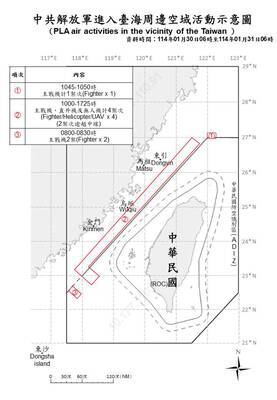The Central Epidemic Command Center (CECC) yesterday reported the first locally acquired cases of new Omicron subvariants XBB and BF.7.
Centers for Disease Control (CDC) Deputy Director-General Philip Lo (羅一鈞), deputy head of the CECC’s medical response division, said that among the 139 sequenced samples of local cases last week, 134 cases (96 percent) were infected with the Omicron BA.5 subvariant, three had the BA.2 subvariant, and one each had the BF.7 and XBB subvariants.
The BF.7 case is a woman in her 60s living in the south who has received three doses of a COVID-19 vaccine, Lo said, adding that she tested positive when she sought treatment on Oct. 19.
The XBB case is a man in his 40s living in northern Taiwan who has received three doses of a COVID-19 vaccine.
He was first diagnosed with COVID-19 on Aug. 30, developed a fever, coughing and runny nose on Oct. 15, and tested positive on Oct. 17, Lo said.
Neither of them had traveled abroad or had any close contact with people who had arrived in Taiwan recently, making them the first locally acquired cases of the XBB and BF.7 subvariants, he said.
Of the 26 sequenced samples of imported cases last week, 54 percent (14 cases) were infected with BA.5, 19 percent (five cases) each had the XBB and BA.2.75 subvariants, and one case had the BQ.1/BQ.1.1 and BA.2 subvariants, he said.
The imported XBB cases arrived from Singapore, Indonesia, India and Thailand, while the BQ.1/BQ.1.1 case arrived from Canada, Lo said, adding that the XBB cases detected so far were all from Southeast Asian countries, while the BQ.1/BQ.1.1 cases arrived from Europe, Canada and the US.
The XBB subvariant is a recombinant of BA.2.10.1 and BA.2.75 subvariants, and WHO data show that it has been reported in 35 countries, with a global prevalence of 1.3 percent, Lo said, adding that the severity of XBB cases is not higher than previous dominant Omicron subvariants.
The XBB cases also showed a higher reinfection rate, but mostly in people who have previously been infected with other COVID-19 variants, such as Alpha or Delta, and there is currently no evidence suggesting that it has higher immune escape from previous infection with Omicron subvariants, Lo said.
The XBB subvariant has become the dominant strain in Singapore, with cases peaking late last month, after it was first detected in July, Lo said, adding that the XBB wave was shorter and had fewer cases than the two previous waves in March and July.
The CECC also reported 22,593 new local cases and 59 deaths.
The local caseload yesterday was 14.2 percent lower than that on Monday last week, said CDC Deputy Director-General Chuang Jen-hsiang (莊人祥), the CECC’s spokesman.
Deputy Minister of Health and Welfare Victor Wang (王必勝), who heads the center, said weekly new local cases have steadily dropped by about 10 percent for three consecutive weeks, and that simulations suggest that the average daily caseload might drop to about 10,000 to 20,000 cases per day by the end of this month.
Chuang said a shipment of 624,000 doses of the Pfizer-BioNTech vaccine for children aged six months to four years arrived yesterday.
The latest batch is due to expire on April 30 next year, he said, adding that was the last of a total order of 1,900,800 doses for this year.
He said the center also discovered that some people are selling their positive at-home COVID-19 rapid test results online, which is against the law, and that it has reported the cases to the prosecutor’s office for investigation.

Taiwanese actress Barbie Hsu (徐熙媛) has died of pneumonia at the age of 48 while on a trip to Japan, where she contracted influenza during the Lunar New Year holiday, her sister confirmed today through an agent. "Our whole family came to Japan for a trip, and my dearest and most kindhearted sister Barbie Hsu died of influenza-induced pneumonia and unfortunately left us," Hsu's sister and talk show hostess Dee Hsu (徐熙娣) said. "I was grateful to be her sister in this life and that we got to care for and spend time with each other. I will always be grateful to

UNITED: The premier said Trump’s tariff comments provided a great opportunity for the private and public sectors to come together to maintain the nation’s chip advantage The government is considering ways to assist the nation’s semiconductor industry or hosting collaborative projects with the private sector after US President Donald Trump threatened to impose a 100 percent tariff on chips exported to the US, Premier Cho Jung-tai (卓榮泰) said yesterday. Trump on Monday told Republican members of the US Congress about plans to impose sweeping tariffs on semiconductors, steel, aluminum, copper and pharmaceuticals “in the very near future.” “It’s time for the United States to return to the system that made us richer and more powerful than ever before,” Trump said at the Republican Issues Conference in Miami, Florida. “They

REMINDER: Of the 6.78 million doses of flu vaccine Taiwan purchased for this flu season, about 200,000 are still available, an official said, following Big S’ death As news broke of the death of Taiwanese actress and singer Barbie Hsu (徐熙媛), also known as Big S (大S), from severe flu complications, the Centers for Disease Control (CDC) and doctors yesterday urged people at high risk to get vaccinated and be alert to signs of severe illness. Hsu’s family yesterday confirmed that the actress died on a family holiday in Japan due to pneumonia during the Lunar New Year holiday. CDC Deputy Director-General Tseng Shu-hui (曾淑慧) told an impromptu news conference that hospital visits for flu-like illnesses from Jan. 19 to Jan. 25 reached 162,352 — the highest

TAIWAN DEFENSE: The initiative would involve integrating various systems in a fast-paced manner through the use of common software to obstruct a Chinese invasion The first tranche of the US Navy’s “Replicator” initiative aimed at obstructing a Chinese invasion of Taiwan would be ready by August, a US Naval Institute (USNI) News report on Tuesday said. The initiative is part of a larger defense strategy for Taiwan, and would involve launching thousands of uncrewed submarines, surface vessels and aerial vehicles around Taiwan to buy the nation and its partners time to assemble a response. The plan was first made public by the Washington Post in June last year, when it cited comments by US Indo-Pacific Commander Admiral Samuel Paparo on the sidelines of the Shangri-La Dialogue